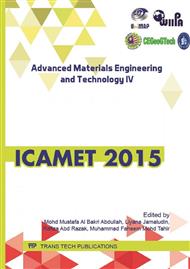p.331
p.337
p.342
p.347
p.352
p.358
p.363
p.367
p.373
Leaching of Heavy Metals Using TCLP and SPLP Method from Fired Clay Brick Incorporating with Mosaic Sludge
Abstract:
Mosaic sludge is sewerage from mosaic industrial activities such as cutting, polishing and grinding. This sludge mostly will be disposed directly to landfill and some of it was discharged in drainage system without proper treatment. Therefore, in this study, mosaic sludge from the mosaic industry were reused and incorporated into fired clay brick in order to provide alternative disposal method, producing adequate quality of brick as well as minimizing the heavy metal leachability to the environment. First, X-Ray Fluorescence (XRF) was conducted to determine the heavy metal concentration from two types of mosaic sludge. The results indicate that the highest element concentration in mosaic sludge (BS and PS) shows that Barium is the highest with 3253ppm and 3260ppm. On the raw sludge, the lowest obtained in BS and PS is Cesium with 14ppm and 17ppm. SPLP and TCLP also conducted in this study and the results show that, even though the element such as ferum (Fe) and cadmium (Cd) was not detected in XRF but in SPLP and TCLP, it shows that these two elements exist in clay, BS and PS with low concentration. In term of properties, compressive strength was conducted by incorporating 0%, 1%, 5%, 10%, 20% and 30% bodymill and polishing sludge into fired clay brick. The results show that compressive strength of BS brick was stronger than PS brick. Lastly, Static Leachate Test (SLT) was conducted to measure the long term leachability of heavy metals from different percentages of mosaic sludge brick. In SLT result, ferum (Fe) shows the highest value of heavy metal concentration among other elements. The results for control brick, BS brick and PS brick show the same pattern and far from the limit set by USEPA.
Info:
Periodical:
Pages:
352-357
Citation:
Online since:
May 2016
Keywords:
Price:
Сopyright:
© 2016 Trans Tech Publications Ltd. All Rights Reserved
Share:
Citation:


